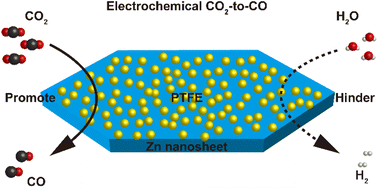Local environment-mediated efficient electrocatalysis of CO2 to CO on Zn nanosheets†
Abstract
Nowadays, the goal of carbon peaking and carbon neutrality has become a global consensus, and electrochemical CO2 reduction to provide high-value power fuel is one of the major technical approaches attracting significant research interests and application prospects. However, the inevitable hydrogen evolution reaction in water-based electrolyte systems crowds out the reactive sites of active metals, causing a low CO2 conversion efficiency. In this work, Zn nanosheets were prepared via electrodeposition on the surface of carbon paper and then modified with polytetrafluoroethylene (PTFE) to tune the wetting angle of the electrolyte. A CO faradaic efficiency of 90.2% was achieved for Zn NS-8% PTFE (contact angle: 136.8°) at the electrolytic voltage of −1.0 V vs. RHE along with an overall current density of −7.9 mA cm−2. Experimental results and molecular dynamics simulation revealed that PTFE weakened the aggregation of H2O molecules and was more beneficial for capturing and adsorbing CO2 molecules near the electrode surface. The active sites of hydrogen production were transformed into the reaction center for electrocatalytic CO2 reduction due to the hydrophobicity of the electrode, and the accumulation of the local CO2 concentration accelerated the kinetic activity for electrochemical conversion (CO2 to CO). This strategy of tuning the local environment offers an alternative approach for effective electrode manufacturing in liquid electrolytes.



 Please wait while we load your content...
Please wait while we load your content...